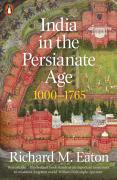India in the Persianate Age

The Indian subcontinent might seem a self-contained world. Protected by vast mountains and seas, it has created its own religions, philosophies and social systems. And yet this ancient land experienced prolonged and intense interaction with the peoples and cultures of East and Southeast Asia, Europe, Africa and, especially, Central Asia and the Iranian plateau between the eleventh and eighteenth centuries. Richard M. Eaton's wonderful new book tells this extraordinary story with relish and originality. His major theme is the rise of 'Persianate' culture - a many-faceted transregional world informed by a canon of texts that circulated through ever-widening networks across much of Asia. Introduced to India in the eleventh century by dynasties based in eastern Afghanistan, this culture would become thoroughly indigenized by the time of the great Mughals in the sixteenth, seventeenth, and eighteenth centuries. This long-term process of cultural interaction and assimilation is reflected in India's language, literature, cuisine, attire, religion, styles of rulership and warfare, science, art, music, architecture, and more. The book brilliantly elaborates the complex encounter between India's Sanskrit culture - which continued to flourish and grow throughout this period - and Persian culture, which helped shape the Delhi Sultanate, the Mughal Empire and a host of regional states, and made India what it is today.